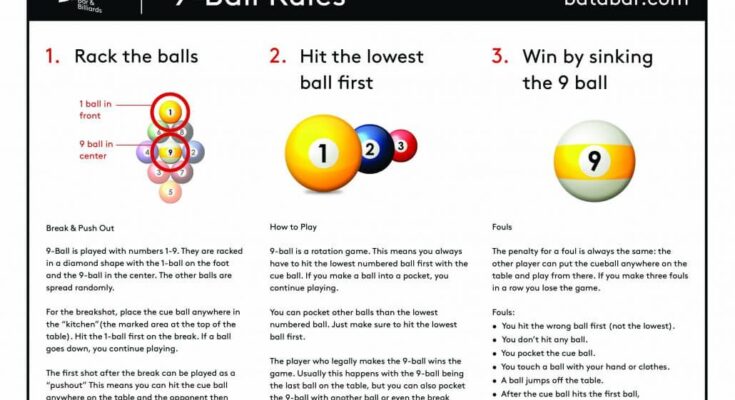Dominate 9-Ball Pool: Essential Rules Guide by Bata
Step up your 9-ball pool game with this expertly crafted infographic from Bata, providing a thorough and visually engaging overview of the official 9-ball rules as outlined by the World Pool-Billiard Association (WPA). Ideal for both novice players and seasoned competitors, this guide breaks down the key elements of 9-ball gameplay—racking, shot order, and winning strategies—into an accessible format. Whether you’re setting up a friendly match or preparing for a tournament, this resource from batabar.com is your go-to for mastering this dynamic cue sport.

The infographic is structured into three pivotal sections, each detailing a crucial aspect of 9-ball:
- Rack the Balls: Discover the proper racking technique with the 1-ball positioned at the front apex and the 9-ball centered in a diamond shape. The remaining balls (2 through 8) are spread randomly within the rack. For the break shot, place the cue ball anywhere in the “kitchen” (the marked area at the top of the table) and ensure the 1-ball is hit first. If a ball is pocketed on the break, the breaking player continues. The first shot post-break can be a “pushout,” allowing flexibility to hit the cue ball anywhere, with the opponent deciding who plays next, adding a strategic layer to the game’s outset.
- Hit the Lowest Ball First: 9-ball is a rotation game where the lowest numbered ball on the table must always be hit first with the cue ball. If you pocket a ball, you continue your turn, giving you the chance to clear the table strategically. The rules allow pocketing higher-numbered balls as long as the lowest ball is struck first, offering tactical depth. Victory hinges on legally pocketing the 9-ball, which can occur as the last ball or even on the break, making every shot a potential game-changer.
- Win by Sinking the 9-Ball: The game concludes when a player legally pockets the 9-ball after hitting the lowest numbered ball first. However, fouls can shift the momentum—after a foul, the opponent can place the cue ball anywhere and take their turn. Accumulate three fouls in a row, and you lose the game. Common fouls include hitting the wrong ball first (not the lowest), missing all balls, pocketing the cue ball, touching a ball with your hand or clothes, causing the cue ball to jump off the table, or failing to hit a ball with the first shot that results in no ball being pocketed.
Sourced from Bata Bar & Billiards and based on the 2015 WPA Rules of Play, this infographic combines practical guidance with striking visuals, making it an excellent tool for learning or teaching 9-ball. Display it in your game room, use it to settle disputes, or share it with fellow players to enhance your next session. With its clear instructions and foul awareness, this guide ensures you play with confidence and precision—start dominating the 9-ball table today!



